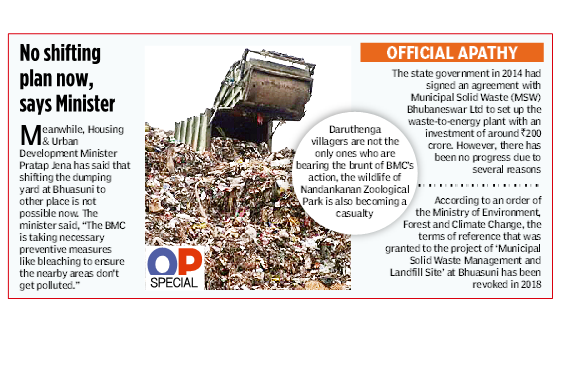Bhubaneswar: The ambitious proposal of Bhubaneswar Municipal Corporation (BMC) to set up a waste-to-energy plant at Bhuasuni dump yard in 2008 has been hanging fire thanks to official procrastination, continuous protests and an NGT rider. Had the waste processing unit been taken up on time, it would have generated 11-MW energy every day which is enough to power more than 2,000 homes.
The state government in 2014 had signed an agreement with Municipal Solid Waste (MSW) Bhubaneswar Ltd to set up the waste-to-energy plant with an investment of around `200 crore. However, there has been no progress due to several reasons.
Meanwhile, the proposal has hit roadblock after the intervention by the National Green Tribunal (NGT) in the issue.
BMC Deputy Commissioner Srimanta Mishra said they look forward to the resolution of the issue at the earliest. But there might be some more stories behind it.
Dumping at Bhuasuni ‘illegal’
According to an order of the Ministry of Environment, Forest and Climate Change, the Terms of Reference (ToR) that was granted to the project of ‘Municipal Solid Waste Management and Landfill Site’ at Bhuasuni has been revoked in 2018. “This means it’s illegal to dump garbage at Bhuasuni dump yard, let alone set up a power plant,” said Tapan Baliarsingh, a resident of the Daruthenga village and Secretary of Balunkeswar Unnayanan Committee (BUC). The group had appealed to the ministry to shift the dump yard and has been fighting for the cause since 2011.
The ToR details the scope of a project and the way in which it should be developed.
Baliarsingh said the BMC’s activities are not in conformity with the nomenclature of the project.
“The project reads ‘solid waste management’, but the civic body is neither managing the wastes in the form of segregation, nor is it setting up a landfill site,” Baliarsingh rued. (Landfills are spaces where disposable waste is dumped and then buried.)
Meanwhile, Daruthenga residents continue to oppose the dump yard vehemently as pollution hazards will haunt them if Bhuasuni continues to remain the city’s designated dump yard. “Since garbage is dumped close to residential areas, the stench emanating from the dump yard is unbearable and there is risk of water contamination,” said a local.
According to sources, Daruthenga villagers are not the only ones who are bearing the brunt of BMC’s action, the wildlife of Nandankanan Zoological Park is also becoming a casualty. The source of the lake inside the zoo is from Bhuasuni. “The seepage from the garbage dump is polluting the lake, resulting in the death of animals,” claims Baliarsingh.
The BUC will continue to pursue the issue. Baliarsingh remains fairly optimistic that the NGT’s ruling would be in their favour.
Dire need for solid waste mechanism
The civic body, however, plans to set up two decentralised waste processing plants in the city. One is a plastic processing unit in the Temporary Transit Station (TTS) near Sainik School and the other is a compost plant for which site identification is awaited, said the BMC deputy commissioner.
Meanwhile, experts are of the view that it’s not enough and it is high time the government pulled up its socks to put up a proper waste management unit in place.
The Capital city produces 520 tonne (approx) solid waste every day. The amount will certainly rise as Bhubaneswar’s population is on the rise. Environmentalists, on the other hand, have attributed the delay in the launch of waste management plant to official procrastination and lack of political will.
It’s worth mentioning here that Bhubaneswar‘s dismal performance in the Swachch Survekshan-2019 was attributed to lack of a solid waste treatment plant in the city.
The way forward
Orissa Environmental Society president SN Patro suggested that the authorities shift the project from Bhuasuni to a site where there is little resistance from the residents.
“The waste-to-energy plant might just be too ambitious for the civic authorities. The waste-to-manure processing unit would be more appropriate for Bhubaneswar,” Patro suggested.
A waste-to-energy plant requires a streamlined process of timely collection and segregation of garbage at the source of generation, the problems that the BMC continues to tackle.
The twin cities of Cuttack and Bhubaneswar would ultimately benefit from a large landfill system to dispose of the waste generated from the cities, Patro added.
Nivedita Nayak, OP







































